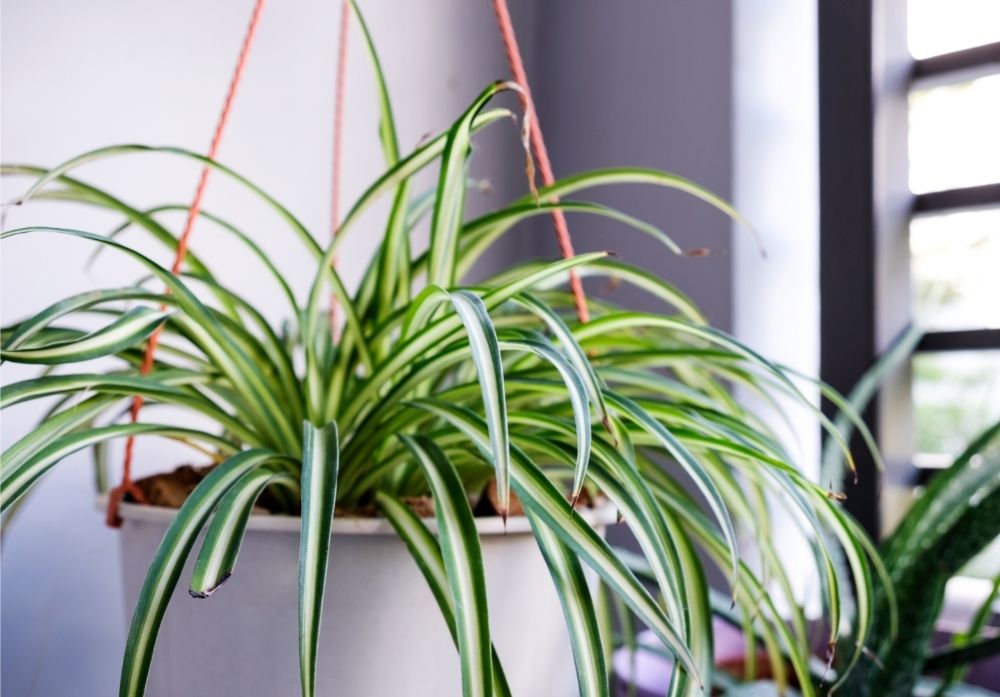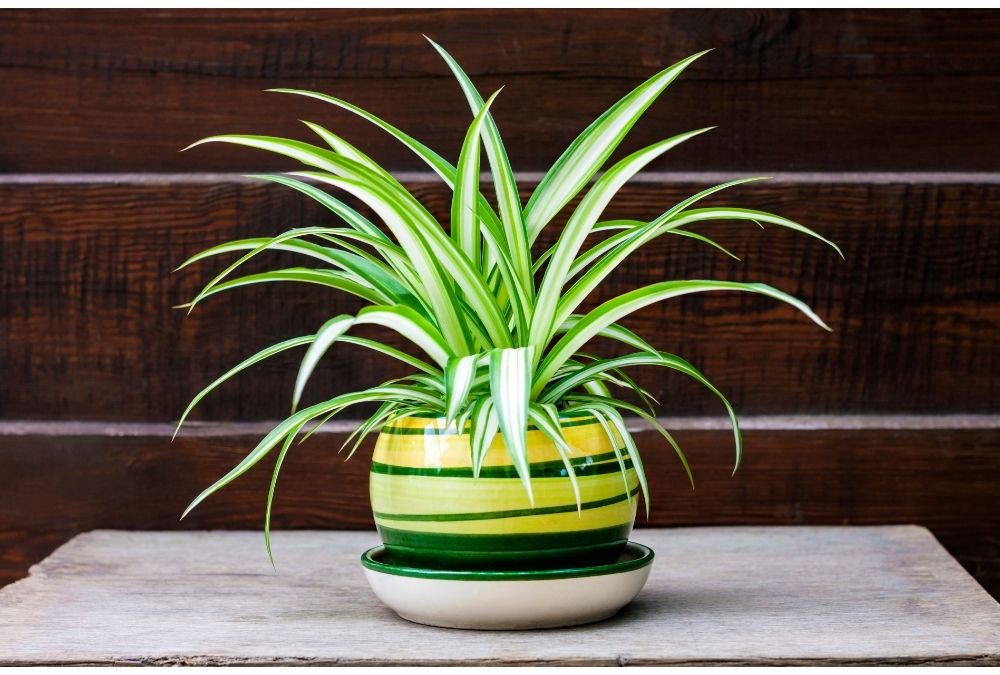Spider Plant
You’ve probably already seen a Spider Plant before at the dentist’s office or hanging from your aunt’s patio and you may not have even known it. They’re some of the most popular plants in the world for a good reason – plant care is easy and they have the perfect houseplant look. But did you know that there are over 200 Spider Plant Varieties?
Each type comes with its own little twist. Most have long, slender leaves that sprout up almost like legs and look the best when hanging from your ceiling or sitting on your patio. Let’s take a look at some of our favorite and most popular ones!
What is a Spider Plant?
The Spider Plant (Chlorophytum comosum) is native to tropical areas in southern Africa but has since been naturalized all over the world. It’s known as a perennial flowering plant, meaning it lives for longer than two years and blooms in spring or summer.
They are typically characterized by long, narrow leaves that can grow up to 24 inches tall and hang down over the side of the pot, making it the ideal hanging plant.
The leaves are typically green, but different variations can have eye-catching white stripes that contrast the green leaves. These variegated forms are actually more popular and have become the face of Spider Plants across the board.

Spider Plant Propagation
One of the coolest things about these plants is how easily they propagate. If you can care for one properly, you can plant the “spiderettes” (a.k.a. pups or plantlets, whatever rolls off your tongue better) to make more Spider Plants.
Plant babies are just as easy to grow as the parent. So, without even trying, your single plant could transform your bland living room into a plant sanctuary in as little as a year.
Another option is to give the new plants away as gifts. Forgot to prepare a white elephant gift? Just bring a baby spiderette!
Spider Plant Quick Care Guide
Here’s a quick rundown of how to care for these beautiful plants:
- Light: Bright, indirect sunlight is best
- Water: Water when the soil is dry, do not overwater
- Temperature: 70 – 90°F
- Soil: Standard, well-draining potting soil
- Humidity: Average
- Size: Up to 24 inches tall
- Placement: Indoors or outdoors
- Propagation: Through spider plant offsets (babies) or cuttings
- Common pests: Aphids, mealybugs, and spider mites
- Toxicity: None; safe for pets
Related: Spider Plant Care: Be the Best Plant Parent with These Tips
What is the Spider Plant Used For?
One of the main draws of these types of plants is that they’re amazing air purifiers!
In 1989, NASA conducted a clean air study to research ways to efficiently clean the air in space stations. The Spider Plant was one of the 19 plants tested in the study. NASA concluded that not only did the plants convert carbon dioxide into oxygen, they also naturally removed harmful air pollutants like carbon monoxide, formaldehyde, and xylene.
So by owning one, you’re not just freshening up your decor, but you’re also cleaning up the air you breathe.
How Many Varieties Are There?
There are over 200 varieties of spider-like plants! They are categorized under the Chlorophytum genus and have similar long, slender leaves, thick roots, and small flowers (typically white-colored).
With so many varieties, it’s easy to find one that fits your taste!
What Are the Most Common Types?
Here are some of the most popular and commonly bought options. We’ve included a few fan favorites that will be the perfect addition to your home!
Spider Plant (Chlorophytum Comosum)
The original spider plant is actually not as common as other variations nowadays. However, its classic and unique look deserves a place on this list. Its leaves are solid green with a lighter green shade in the middle, setting it apart from the more popular variegated types.
Variegated Spider Plant (Chlorophytum Comosum ‘Vittatum’)
The Variegated version is one of the most beloved and popular varieties, peaking in popularity in the 90s. A white stripe in the middle highlights the long green leaves. This version is iconic, and when you think of a Spider plant, you probably imagine the variegated type in a hanging basket!
Reverse Variegated Spider Plant (Chlorophytum Comosum ‘Variegatum’)
Take the Variegated and reverse the colors to get the Variegatum. The margins are white with a broad dark green stripe that runs through the center of the leaves. This variation is growing in popularity because it’s just slightly different than the typical variegated kind.
Bonnie Spider Plant (Chlorophytum Comosum ‘Bonnie’)
The Bonnie has curled leaves arranged into a loose, messy bun. The colors are the same as the Variegatum, but the shape is completely unique. The Bonnie is popular for its shape and because it’s a bit more compact than typical variations.
Zebra Spider Plant (Chlorophytum Laxum)
The “Zebra” version is a fast-growing plant that looks similar to the Variegatum. The leaves have a broad green center, but instead of white margins, they’re yellow! Over time, the margins eventually turn white (I know, it’s confusing). Nevertheless, the yellow color is noteworthy among spider plants.
Hawaiian Spider Plant (Chlorophytum Viridescens ‘Golden Glow’)
The Hawaiian Spider Plant stands out among its peers because of its lush and exotic colors. The glossy green leaves fade to a beautiful champagne color in the middle. This type is also known as “Golden Glow” and will brighten up any room!
Orchid Spider Plant (Chlorophytum Orchidastrum ‘Green Orange’)
This one deviates from the typical look of these plants. Instead of long slender leaves, the Orchid has broad green leaves. The leaves fade down to orange stems that seem to glow in the right light. The general shape is similar to other variations, but its fiery orange color sets it apart from every other variety.

Which Plants Are Similar to Spider Plants?
So you’re looking for something with the look and colors of a spider plant, but isn’t exactly a spider plant? Here are a few options:
- Dracaena: Although the leaves tend to be broader than the Spider’s, they have the same ‘sprouting’ look and varied green colors.
- Snake Plant: A sturdy succulent with straight, upright leaves in beautiful shades of green.
- Tillandsia: Also known as “air plants,” these little guys have varied colors but the same spiky look – reminiscent of tufts of grass.
Final Thoughts – Spider Plant Varieties
Spider plants aren’t just your grandma’s plant anymore. Younger generations of adults have jumped into the world of plants and represented a huge increase in the growth of the houseplant industry in recent years. It’s time to jump on the train and own a few plants for yourself!
There are so many varieties of this plant and each offers its own unique charm. So when you decide to buy a Spider Plant, don’t just settle for normal anymore. Explore the many options available to find the perfect one to fit your household!